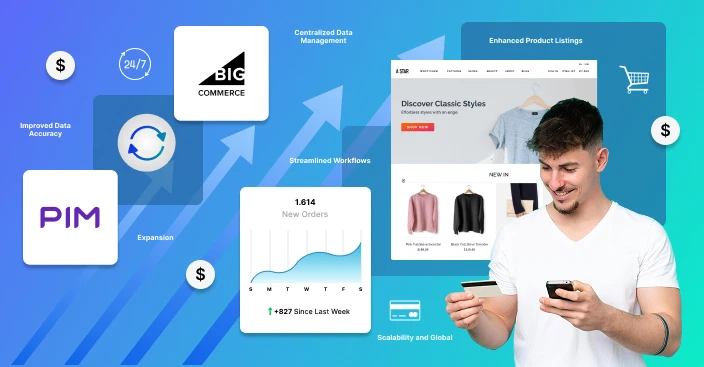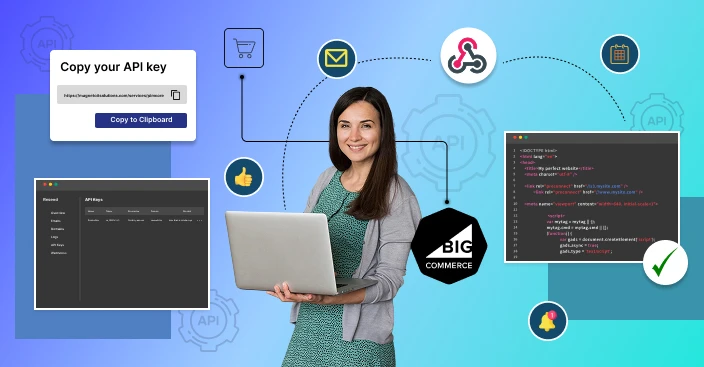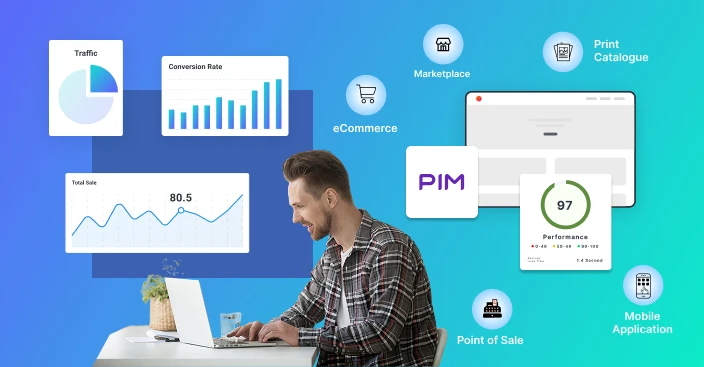Step-by-Step Guide on Integration of PIM and BigCommerce for eCommerce Growth

In eCommerce, being competitive is all about being efficient, and effective product information management is the key to that efficiency.
As eCommerce websites expand their product lists and start selling through multiple channels, a bigger and bigger problem begins to surface: how to make it consistent, accurate, and high-quality for each and every product listing.
That’s where Product Information Management (PIM) enters the picture. And when combined with a robust platform such as BigCommerce, what you have is streamlined operations, quicker launches, and improved customer experiences.
In this blog, we will cover how the combination of a PIM system and BigCommerce can be a transformation for your eCommerce company. We will also help you with by step-by-step integration process, point out key benefits, to ensure complete understanding and growth.
Defining Product Information Management (PIM)
A product information management system essentially gathers and organizes all of your product data in one place.
Product names and descriptions, specifications, prices, inventory information, and images may all be appropriately stored, updated, and shared across a variety of sales platforms with the use of a PIM.
For eCommerce scaling, especially those based on BigCommerce, product data management manually or in a very small CMS infrastructure is soon not viable.
Without PIM, you’re at risk of ending up with wrong product information, stale data, and behind in driving product updates. These do more than slow you down; these kill customer trust and search rankings.
Why Integrate PIM with BigCommerce
BigCommerce is well scalable and flexible to retailers, but it cannot render a special system required to handle large catalogs unnecessary.
If you use BigCommerce in conjunction with a PIM solution, you have a fantastic combination that brings greater agility and smarter decision-making.
For the first time in history, a PIM guarantees that all your product data is uniform across every channel.
This uniformity generates customer trust, prevents confusion, and reduces returns. Second, it speeds up time from development to market with products. Instead of waiting to upload content manually to BigCommerce, everything is synchronized and automated in real-time from a single source.
Lastly, this integration facilitates omnichannel selling operations. A PIM guarantees that every point of sale have current, enhanced product information that is especially suited to each platform’s particular needs, whether you’re selling from your BigCommerce website, Amazon, eBay, or another location.
Additionally, the organized data of a PIM platform boosts your site’s SEO. Once product pages are filled with precise, keyword-based data, they’re likely to rank higher on search engine pages. This is a strategic benefit for any e-business seeking growth.
Key Steps To Integrate PIM and BigCommerce
Step 1: Selecting the Best PIM System for Your Business
The initial step is to choose a PIM that is suitable for your business model and catalog complexity.
If you are a rapidly growing retailer with hundreds of thousands of SKUs, Akeneo or Salsify would be perfect because they are scalable and feature-rich. Small businesses might find cheaper tools like Plytix more suitable because it is easy to use and budget-friendly.
When selecting, make sure your PIM allows BigCommerce integration through natively connected connectors, APIs, or middleware software such as Alumio or Celigo. This integration is vital for smooth data exchange between systems.
Step 2: Preparing Your Data for Integration
Prior to integration, it is critical to conduct a complete product data audit. Begin with the identification of incomplete attributes, conflicting naming conventions, obsolete information, or absent assets such as images and documents. This is not glamorous work, but it is necessary.
You should also be sure that your taxonomy—categories, variants, SKUs, tags—is aligned with BigCommerce’s data structure. Consider this step as doing spring cleaning on your product database before it enters its new home.
For instance, Black Diamond, an American brand that makes climbing and outdoor equipment, implemented Akeneo with their BigCommerce website.
Prior to synchronization, they reviewed all their multilingual and multichannel product data thoroughly to ensure compliance with regional requirements, formats, and so on. Thus, launching new products at U.S. and international stores simultaneously is now just a matter of days, whereas it used to take weeks.
Step 3: Introducing PIM to BigCommerce
Once your data is ready, you can go ahead and start integrating. The integration is performed via either a native connector or middleware, depending on the PIM you choose. Salsify, for instance, offers a pre-built integration with BigCommerce that allows for real-time sync of product data, images, and pricing.
You may also want to specify your synchronization logic in this step, such as whether you want these instances to update in real time, on a scheduled basis, or just update when they meet certain conditions.

In this step, you’ll also define your synchronization logic, whether updates should occur in real time, at scheduled intervals, or only when specific criteria are met. Some businesses choose to sync only “complete” products, meaning those that have met predefined content scores or attribute requirements.
Testing is important here. Begin with a small product batch to verify formatting, test how the images appear, and confirm that the product variants, descriptions, and metadata are displaying correctly on the BigCommerce storefront.
Step 4: Full Sync Deployment and Team Training
Once tested successfully, it is now time to execute a full sync. This will update your whole product catalog from PIM to BigCommerce. Based on catalog size, this will take minutes to hours.
But stop there, train your teams. Anyone who is touching product development, marketing, or inventory management needs to know how the new system works.
With defined roles and workflows, your PIM is a real-time source of enhanced data, fueling not only BigCommerce but also other touchpoints such as Amazon, Walmart, Google Shopping, or your mobile application.
Example: Nestlé Health Science’s U.S. business unified Salsify with BigCommerce to centrally manage product listings on their DTC health and wellness store.
With the marketing and product teams onboarded to update and go live with products through the PIM, manual touchpoints were minimized to secure consistency in product storytelling on all digital channels.
Step 5: Monitor, Optimize, and Scale
While the integration can be implemented it must go through a constant period of monitoring. Monitor for sync failures, any form of inconsistent data, or SKU discrepancies. KPI measurement should include product page load speeds, search engine optimization rank, return rates, and conversion enhancements.
As your company expands, keep refining your workflows. Automate additional fields, extend product content enrichment even further, or even extend to new languages and regional catalogs, your PIM will grow with you.
Over time, you’ll notice operational efficiency, reduced content errors, and a more engaging customer journey. This is where your investment in PIM truly starts delivering ROI.
PIM and BigCommerce Integration Fuels eCommerce Growth
The advantages of such integration go beyond convenience. Properly executed, BigCommerce PIM integration can be a growth driver for your business.
First, it greatly improves the customer experience greatly improved. Customers are more apt to purchase when they are able to readily access rich, accurate, and compelling product data.
You are also able to launch new collections or flash sales more rapidly through a centralized platform, allowing you to react rapidly to seasonal demands or topical market conditions.
Operational efficiency is another massive benefit. Your staff will have so much less time spent manually entering data or reconciling errors between systems. Instead, they’ll be able to focus on honing product content, running campaigns, or finding new markets.

Finally, the integration sets you up for scalability. If your catalog expands or if you’re expanding into a new region, your product data infrastructure will be able to handle that growth without latency or drag.
BigCommerce and PIM Integration in Action
Skullcandy
Skullcandy, Utah-based audio brand, was growing rapidly across various online platforms including Amazon, Walmart, and its own BigCommerce site.
As their product range increased, handling data manually was a hindrance. Description discrepancies, image issues with formatting, and launch delays were compromising their customer experience and productivity.
This amount of data in check manually within BigCommerce was time-consuming and susceptible to error.
Skullcandy solved these problems by picking Salsify as its backbone PIM and integrating it with BigCommerce. Now their marketing and merchandising teams can polish product data in one central repository and share it across multiple touchpoints instantaneously.
Somewhere down the line, this had accelerated their product launch cycle by well over 40%, which also improved their SEO, provided asylum for brand messaging, and mitigated listing-error cases to a large extent.
This streamlined infrastructure was hence implemented to assist Skullcandy in offering a unified, high-quality product experience at scale.
Nestlé Health Science USA
Being another branch of the worldwide food and nutrition leader, Nestlé Health Science faced very specific challenges on sidelines while scaling its direct-to-consumer business in the United States.
Their product listing had innumerable categories of health supplements and nutritional products that needed to observe stringent FDA labeling and compliance standards. Manipulating this amount of data manually in BigCommerce was very time-consuming and prone to error.
To solve this, they implemented Salsify as their PIM system and tied it to their BigCommerce store. The outcome was a centralized system for handling everything from ingredient statements to copy for marketing, which could be edited and deployed live in an instant.
This automation cut labor by 60%, provided consistent and compliant product content on every digital channel, and allowed for more rapid rollout of new products and promotion campaigns.
The integration provided Nestlé with the nimbleness to expand its DTC business with regulatory precision and control of operations.
Integrating a PIM with BigCommerce is an intelligent decision for eCommerce companies that want to automate processes, enhance product data accuracy, and grow the brand on all channels. It brings order to your product data, enables quicker launches, and enables you to trust your customers.
Final Thoughts
Combining a PIM with BigCommerce is the right choice for eCommerce companies to automate operations, enhance product accuracy, and grow their brand across channels.
It adds order to your product data, enables quicker launches, and enables you to be more trusted by your customers.
But achieving such integration success depends on choosing the correct partner. Connecting with an expert can help you conduct a complete integration from tool choice and data cleaning to complete implementation and continuous optimization.
Talking to an experienced BigCommerce and PIM integration expert can be beneficial for getting the full benefit of your store and ensuring an excellent outcome.
FAQs
 What is the role of a PIM system in BigCommerce-based online stores?
What is the role of a PIM system in BigCommerce-based online stores?
A PIM is an essential tool in controlling and bringing together all product data. For BigCommerce stores, a PIM makes things easy by having consistent, correct, and enriched product data on your store and across other sales channels. It eliminates manual work, accelerates time-to-market, and improves the customer experience.
 Can you implement any Product data management software with BigCommerce?
Can you implement any Product data management software with BigCommerce?
Yes, most up-to-date PIM solutions such as Akeneo, Salsify, Plytix, and Pimcore are either natively integrated with BigCommerce or integrated with BigCommerce through APIs and middleware. Which type of integration will help you depends on business requirements, tech stack, and the complexity of product data. Working with an experienced BigCommerce partner will provide you with an excellent integration route that is smooth and scalable.
 How much time will it take for PIM integration with BigCommerce?
How much time will it take for PIM integration with BigCommerce?
Depending on how complex or how simple your catalog is, plus the PIM systems you want to implement, and the extent of integration you want, the timeline can be different. Simple integration takes 4-6 weeks while more complicated configurations may require 8-12 weeks. A great advantage is that proper planning and auditing before the actual integration can come in handy during the process itself and may save you time.
 How does PIM Integration aid in maintenance and scaling of BigCommerce stores?
How does PIM Integration aid in maintenance and scaling of BigCommerce stores?
IAM PIM Integration keeps store information updated with updates on product data and reduces the risk of errors in manual entry, thus, scaling the BigCommerce store across newer channels or geographies.
 Does Magneto IT Solutions support PIM and BigCommerce after integration?
Does Magneto IT Solutions support PIM and BigCommerce after integration?
Yes. We do provide post-integration maintenance support for monitoring sync, troubleshooting, system optimization, and training for your team.
 Why do I need to use Magneto IT Solutions for BigCommerce development and PIM integration?
Why do I need to use Magneto IT Solutions for BigCommerce development and PIM integration?
Magneto IT Solutions brings more than 14 years of eCommerce excellence and has successfully delivered 250+ projects globally. We possess very strong BigCommerce architecture skills, along with hands-on experience implementing best-of-breed PIM solutions, which differentiate us. We provide customized solutions to fit your business objectives, providing seamless implementation and 24/7 support to ensure long-term success.




